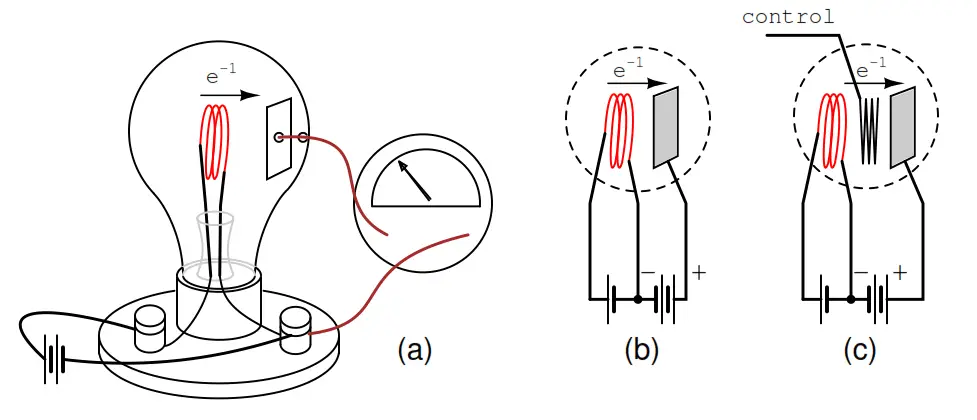This third volume of the book series Lessons In Electric Circuits makes a departure from the former two in that the transition between electric circuits and electronic circuits is formally crossed.
Electric circuits are connections of conductive wires and other devices whereby the uniform flow of electrons occurs. Electronic circuits add a new dimension to electric circuits in that some means of control is exerted over the flow of electrons by another electrical signal, either a voltage or a current.
Electronic Circuits
In and of itself, the control of electron flow is nothing new to the student of electric circuits. Switches control the flow of electrons, as do potentiometers, especially when connected as variable resistors (rheostats). Neither the switch nor the potentiometer should be new to your experience by this point in your study.
The threshold marking the transition from electric to electronic, then, is defined by how the flow of electrons is controlled rather than whether or not any form of control exists in a circuit. Switches and rheostats control the flow of electrons according to the positioning of a mechanical device, which is actuated by some physical force external to the circuit.
In electronics, however, we are dealing with special devices able to control the flow of electrons according to another flow of electrons, or by the application of a static voltage. In other words, in an electronic circuit, electricity is able to control electricity.
Thomas Edison
The historic precursor to the modern electronics era was invented by Thomas Edison in 1880 while developing the electric incandescent lamp.
Edison found that a small current passed from the heated lamp filament to a metal plate mounted inside the vacuum envelop. (Figure 1.1 (a)) Today this is known as the “Edison effect”.
Note that the battery is only necessary to heat the filament. Electrons would still flow if a non-electrical heat source was used.
Figure 1.1: (a) Edison effect, (b) Fleming valve or vacuum diode, (c) DeForest audion triode vacuum tube amplifier.
Vacuum Diode
By 1904 Marconi Wireless Company adviser John Flemming found that an externally applied current (plate battery) only passed in one direction from filament to plate (Figure 1.1 (b)), but not the reverse direction (not shown).
This invention was the vacuum diode, used to convert alternating currents to DC. The addition of a third electrode by Lee DeForest (Figure 1.1 (c)) allowed a small signal to control the larger electron flow from filament to plate.
Audion Tube
Historically, the era of electronics began with the invention of the Audion tube, a device controlling the flow of an electron stream through a vacuum by the application of a small voltage between two metal structures within the tube.
A more detailed summary of so-called electron tube or vacuum tube technology is available in the last chapter of this volume for those who are interested.
Transistor
Electronics technology experienced a revolution in 1948 with the invention of the transistor. This tiny device achieved approximately the same effect as the Audion tube, but in a vastly smaller amount of space and with less material.
Transistors control the flow of electrons through solid semiconductor substances rather than through a vacuum, and so transistor technology is often referred to as solid-state electronics.

